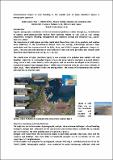Por favor, use este identificador para citar o enlazar a este item:
http://hdl.handle.net/10261/172192COMPARTIR / EXPORTAR:
 SHARE
BASE SHARE
BASE
|
|
| Visualizar otros formatos: MARC | Dublin Core | RDF | ORE | MODS | METS | DIDL | DATACITE | |

| Campo DC | Valor | Lengua/Idioma |
|---|---|---|
| dc.contributor.author | Suárez Ruiz, Isabel | es_ES |
| dc.contributor.author | Pérez, Alberto | es_ES |
| dc.contributor.author | Tomillo, Pelayo | es_ES |
| dc.contributor.author | Luis, Dionisio | es_ES |
| dc.contributor.author | Amor Rubio, Consuelo | es_ES |
| dc.date.accessioned | 2018-11-14T13:45:27Z | - |
| dc.date.available | 2018-11-14T13:45:27Z | - |
| dc.date.issued | 2018-09 | - |
| dc.identifier.citation | The Society for Organic Petrology Newsletter 35(3): 12-16 (2018) | es_ES |
| dc.identifier.issn | 0743-3816 | - |
| dc.identifier.uri | http://hdl.handle.net/10261/172192 | - |
| dc.description.abstract | Organic petrography contributes to the environmental pollution studies through e.g., identification of organic particulates/particles derived from activities related to coal such as coal mining, preparation, transport, blending, management and shipment, storage and utilization (e.g., Suárez-Ruiz et al., 2012). The importance of solid organic particles (particularly those from coals, its by-products and residues from utilization) in the environment derives from the existing relationships between these particulates and the concentration of the PCBs, PAHs, and PCDD/Fs organic pollutants (Yang et al., 2008). The coal and solid residues of coal utilization (chars and coke particles) also contain some hazardous trace elements (such as Hg, As, V, Se, etc.). The coastal area of Gijon (Northern Spain) is one example of a polluted area related with coal handling. Gijon city is surrounded (Figure 1) by a coal power plant, a coal park, a cement industry using coal as a fuel, a steel industry with coke plants, and the activities developed at the El Musel, a commercial seaport that manages about 7 million tons of coal and coke per year (Port Authority of Gijon 2018). These industrial activities are among others, the source of carbonaceous dust storms affecting the city and the coast. | es_ES |
| dc.description.sponsorship | This work was developed within the framework of the INCAR-CSIC and the University of Oviedo (Spain) agreement for the practical training of students. | es_ES |
| dc.language.iso | eng | es_ES |
| dc.publisher | Society for Organic Petrology | es_ES |
| dc.relation.isversionof | Postprint | es_ES |
| dc.rights | openAccess | es_ES |
| dc.title | Environmental impact of coal handling in the coastal area of Gijon (Northern Spain): A petrographic approach | es_ES |
| dc.type | artículo | es_ES |
| dc.description.peerreviewed | Peer reviewed | es_ES |
| dc.relation.publisherversion | https://www.tsop.org/newsletters/35_3.pdf | es_ES |
| dc.rights.license | https://creativecommons.org/licenses/by-nc-nd/4.0/ | es_ES |
| dc.relation.csic | Sí | es_ES |
| oprm.item.hasRevision | no ko 0 false | * |
| dc.contributor.orcid | Suárez Ruiz, Isabel [0000-0003-4941-2797] | es_ES |
| dc.type.coar | http://purl.org/coar/resource_type/c_6501 | es_ES |
| item.openairetype | artículo | - |
| item.grantfulltext | open | - |
| item.cerifentitytype | Publications | - |
| item.openairecristype | http://purl.org/coar/resource_type/c_18cf | - |
| item.fulltext | With Fulltext | - |
| item.languageiso639-1 | en | - |
| Aparece en las colecciones: | (INCAR) Artículos | |
Ficheros en este ítem:
| Fichero | Descripción | Tamaño | Formato | |
|---|---|---|---|---|
| Environmental_impact_Coal_Suárez-Ruiz.pdf | 567,43 kB | Adobe PDF |  Visualizar/Abrir |
CORE Recommender
Page view(s)
355
checked on 19-abr-2024
Download(s)
305
checked on 19-abr-2024
Google ScholarTM
Check
Este item está licenciado bajo una Licencia Creative Commons

